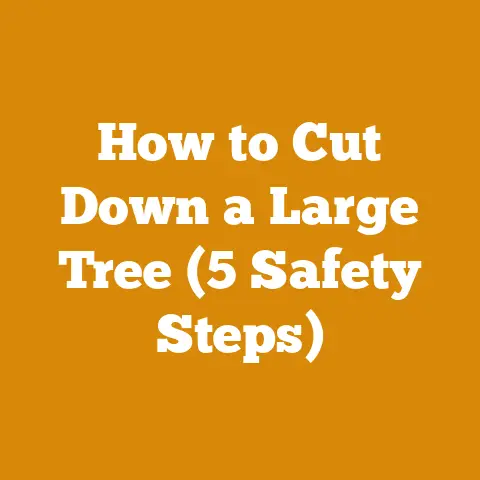Tachometer for Chainsaw (4 Tools You Need)
Imagine you’re out in the woods, ready to handle a day’s worth of cutting.
Your chainsaw’s purring, but is it really performing at its best?
That’s where a tachometer comes into play.
Why You Need a Tachometer
A tachometer measures your chainsaw’s engine RPM (revolutions per minute), ensuring it’s running efficiently.
Running too fast or too slow can wear out the engine prematurely.
Trust me, an efficient chainsaw makes all the difference.
Have you ever had your saw stall midway through a cut?
I have, and it’s frustrating!
4 Must-Have Tachometer Tools
1. Digital Handheld Tachometer
These are compact, user-friendly devices.
I’ve used them countless times when tuning my chainsaws.
Simply point it at the spark plug wire, and it reads the RPMs instantly.
How to Use:
- Start Your Chainsaw – Ensure it’s running at idle.
- Aim the Tachometer – Point it at the spark plug wire.
- Read the Display – Note the RPM and compare it to the manufacturer’s specifications.
Safety Tip: Always wear protective gear. Those chainsaw blades are no joke!
More on Digital Tachometers:
Digital handheld tachometers are incredibly versatile.
They’re not just for chainsaws; you can use them on various small engines.
I once helped a friend tune his lawnmower using the same device.
It was fascinating to see how a simple gadget could make such a difference across different machines.
Common Questions:
- Can I use a digital tachometer for other tools? Yes, they’re great for various small engines.
- How accurate are these devices? Most models are highly accurate if used correctly.
2. Wireless Tachometer
These gadgets use wireless technology, making them easy to use without getting tangled in wires.
How to Use:
- Attach the Sensor – Place it on the engine’s exterior.
- Sync with the Device – Follow the instructions for pairing.
- Check RPM – Read the RPM on your smartphone or display device.
Warning: Double-check the sensor’s placement to ensure accurate readings.
More on Wireless Tachometers:
Wireless tachometers offer flexibility that wired versions don’t.
Imagine being able to move around freely while monitoring your chainsaw’s performance.
I remember a time when I was working in tight spaces; not having wires in the way was a blessing.
Common Questions:
- Do wireless tachometers have connectivity issues? Rarely, but always ensure batteries are charged and connections are secure.
- Is there a range limit? Typically, yes, but it’s usually sufficient for typical use.
3. Contact Tachometer
Unlike digital tachometers, this requires physical contact with the engine.
How to Use:
- Find a Contact Point – Usually on the flywheel.
- Press the Device Against It – Hold steady for a few seconds.
- Record RPM – Take the reading from the display.
Caution: Make sure your chainsaw is securely placed to avoid accidents.
More on Contact Tachometers:
Contact tachometers are old-school but reliable.
They remind me of the days working with my father, who swore by these devices for their precision.
They’re a bit more hands-on, which I appreciate as it connects you more directly with the machinery.
Common Questions:
- Are they more accurate than non-contact types? They can be, as long as they’re used correctly.
- Do they require calibration? Periodically checking calibration ensures accuracy.
4. Strobe Tachometer
This one’s a bit more advanced and needs some practice.
How to Use:
- Set Up the Strobe Light – Position it near the engine.
- Adjust Flash Rate – Match it to the engine’s speed.
- Read RPM – Once stable, note the readings.
Tip: Use this for more precise tuning, especially if you’re into performance tweaking.
More on Strobe Tachometers:
Strobe tachometers are fascinating tools that feel almost magical when you see them in action.
I remember using one for the first time and being amazed at how it seemed to freeze time by synchronizing with the engine’s speed.
Common Questions:
- Is this suitable for beginners? It might be challenging initially but rewarding if you’re willing to learn.
- What are typical uses beyond chainsaws? They’re great for high-precision applications like aviation or performance tuning in motorsports.
Prerequisites for Using a Tachometer
- Basic understanding of chainsaw parts.
- Familiarity with safety procedures.
- A clean and safe working environment.
Equipment Required
- Protective gear: gloves, goggles, ear protection.
- The specific tachometer tools.
- Chainsaw maintenance manual.
Tuning Your Chainsaw with a Tachometer
Tuning is crucial for optimal performance. Here’s how I usually do it:
- Check Idle Speed – Adjust using the idle screw if needed.
- Adjust High-Speed Setting – Ensure it’s within the recommended RPM range.
- Test Cut – Make a few cuts and see if adjustments are needed.
Safety Callout: Always test in an open, clear area away from bystanders.
In-Depth Tuning Process:
Tuning isn’t just about turning screws; it’s about understanding your machine’s unique quirks and characteristics.
Every chainsaw I’ve owned has had its personality, and tuning becomes an art form when you get to know them well.
Troubleshooting Common Issues
Chainsaw Not Reaching Ideal RPM?
- Check for air leaks or clogs in the air filter.
- Inspect the fuel mixture; it might need adjusting.
Inconsistent Readings?
- Ensure connections are secure.
- Replace batteries in your tachometer.
Additional Troubleshooting Tips:
When troubleshooting, patience is key.
I once spent an entire afternoon diagnosing a stubborn issue, only to discover a tiny crack in a fuel line causing air leaks.
It’s moments like these that teach you perseverance pays off.
Personalized Insights
Years back, I recall helping a buddy who had trouble with his saw stalling during cuts.
We used my trusty digital tachometer, found his RPMs were way off, and tuned his saw right there in the woods.
It was a game-changer!
More Personal Stories:
There’s something rewarding about sharing knowledge with friends or fellow enthusiasts.
I’ve had numerous campfire discussions where we exchanged tips and stories about our favorite tools and techniques.
Important Reminders & Next Steps
Keep your tachometer handy for regular tune-ups.
Routine checks prevent surprises and extend your chainsaw’s life.
Maintenance Practices:
Regular maintenance isn’t just about longevity; it’s about reliability when you need it most.
Consistency in care saves time and trouble down the line.
FAQs
Can I use any tachometer on my chainsaw?
Not all tachometers work with every chainsaw. Check compatibility before purchasing.
How often should I check my chainsaw’s RPM?
I recommend before each major job or every few weeks if you’re using it regularly.
What happens if my chainsaw runs above recommended RPMs?
It can lead to engine damage and increase wear and tear over time.
Can I tune my chainsaw without a tachometer?
You can, but it’s less precise. A tachometer ensures accurate tuning for optimal performance.
That’s how you can keep your chainsaw running smoothly with a tachometer!
Got any questions or stories of your own?
Feel free to share them!






